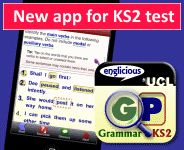Topic: Adverbial
These resources relate to the grammatical function Adverbial. Adverbials are often optional elements in the clause which express circumstances of the situation such as where, when, how or why it happens. An example is in the afternoon in She had a nap in the afternoon. These resources show that there is a wide variety of Adverbials in terms of form, meaning, and position in the clause.
Englicious contains many resources for English language in schools, but the vast majority of them require you to register and log in first. For more information, see What is Englicious?

